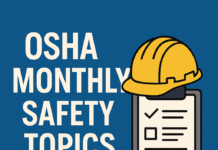
OSHA 2024: Navigating the Future of Workplace Safety
In the dynamic landscape of workplace safety, the Occupational Safety and Health Administration (OSHA) stands as a pivotal entity ensuring the well-being of employees across various industries. As we step into 2024, OSHA undergoes significant changes and updates, marking a new era in occupational safety.
Introduction to OSHA 2024
1.1 Background and Purpose
The Occupational Safety and Health Administration, established in 1970, has been a cornerstone in ensuring safe and healthy working conditions for American workers. With the evolution of industries and technologies, OSHA continually adapts to meet the challenges of the modern workplace.
1.2 Significance of OSHA
OSHA plays a crucial role in preventing workplace injuries, illnesses, and fatalities by setting and enforcing standards and regulations. The year 2024 brings forth a series of updates aimed at enhancing the effectiveness of OSHA in safeguarding workers’ well-being.
Key Changes and Updates
2.1 Regulatory Enhancements
One of the primary focuses of OSHA 2024 is the enhancement of regulatory frameworks. The new standards address emerging risks and technological advancements, ensuring that businesses stay abreast of safety requirements.
2.2 Technological Integration
The integration of cutting-edge technologies is a hallmark of OSHA 2024. From advanced monitoring systems to artificial intelligence-driven safety protocols, technology becomes a powerful ally in the pursuit of a safer workplace.
Impact on Workplace Safety
3.1 Employee Training Programs
OSHA 2024 emphasizes comprehensive employee training programs. These initiatives not only enhance workers’ skills but also instill a safety-first culture within organizations.
3.2 Safety Protocols and Compliance
Stricter safety protocols and increased compliance requirements are integral to the new OSHA guidelines. Companies are now expected to invest in robust safety measures to ensure full adherence.
Industry-Specific Guidelines
4.1 Manufacturing
For the manufacturing sector, OSHA 2024 introduces industry-specific guidelines to address the unique challenges and risks associated with the production environment.
4.2 Healthcare
In the healthcare industry, where worker safety is paramount, OSHA 2024 provides tailored guidelines to mitigate risks and ensure a secure working environment.
OSHA 2024 Compliance Challenges
5.1 Implementation Issues
Despite the positive intent behind OSHA 2024, businesses face challenges in implementing the new regulations. From understanding the changes to incorporating them into existing practices, the transitional phase is marked by hurdles.
5.2 Potential Solutions
To overcome these challenges, businesses must invest in training and education, leveraging resources provided by OSHA and other industry experts. Collaborative efforts can streamline the transition, making compliance more manageable.
International Perspectives on OSHA 2024
6.1 Global Harmonization
OSHA 2024 is not confined to national borders. The global harmonization of occupational safety standards fosters collaboration among nations, creating a safer working environment worldwide.
6.2 Cross-Border Collaborations
International collaboration becomes paramount in addressing global challenges. OSHA 2024 encourages cross-border partnerships to share best practices and collectively tackle emerging safety concerns.
Stakeholder Involvement
7.1 Government Agencies
Government agencies play a crucial role in the successful implementation of OSHA 2024. Collaborative efforts between regulatory bodies and businesses are essential to ensure a smooth transition.
7.2 Business Organizations
Businesses are not merely recipients of regulations but active contributors to safety. OSHA 2024 emphasizes the role of businesses in fostering a culture of safety, making it a shared responsibility.
Future Trends in Occupational Safety
8.1 Predictive Analytics
The future of occupational safety lies in predictive analytics. By analyzing past incidents and near-misses, companies can proactively identify and address potential hazards before they escalate.
8.2 Continuous Improvement Strategies
OSHA 2024 encourages a culture of continuous improvement. Companies are urged to regularly assess and enhance their safety protocols to stay ahead of evolving risks.
Balancing Compliance and Innovation
9.1 Encouraging Innovation
While compliance is non-negotiable, OSHA 2024 recognizes the importance of innovation. The balance between adherence to regulations and fostering a culture of innovation ensures sustained growth and competitiveness.
9.2 Safeguarding Worker Rights
Worker rights remain a cornerstone of OSHA 2024. The regulations not only protect employees from physical harm but also safeguard their rights to a fair and just working environment.
Public Awareness and Education Initiatives
10.1 Outreach Programs
Public awareness is key to the success of OSHA 2024. Outreach programs aim to educate both employers and employees about the new regulations, fostering a shared understanding of the importance of workplace safety.
10.2 Educational Partnerships
Collaboration with educational institutions ensures a continuous influx of well-trained individuals into the workforce. OSHA 2024 promotes partnerships to align education with the evolving needs of industries.
Measuring the Effectiveness of OSHA 2024
11.1 Key Performance Indicators
The effectiveness of OSHA 2024 is measurable through key performance indicators. From reduced accident rates to increased compliance levels, businesses can track their progress in creating safer workplaces.
11.2 Feedback Mechanisms
Feedback mechanisms, including employee surveys and incident reporting systems, serve as valuable tools in assessing the impact of OSHA 2024. Continuous feedback ensures the regulations remain dynamic and responsive to emerging challenges.
Challenges for Small Businesses
12.1 Compliance Costs
Small businesses often face challenges in allocating resources for compliance. OSHA 2024 recognizes these concerns and provides guidance on cost-effective measures to meet regulatory standards.
12.2 Resource Limitations
Limited resources should not be a barrier to safety. OSHA 2024 offers support and resources to help small businesses overcome challenges and prioritize the well-being of their employees.
To find the most current information on OSHA regulations in 2024, I recommend visiting the official OSHA website (https://www.osha.gov/) or contacting OSHA directly for the latest guidelines and regulations applicable to occupational safety and health in the United States.Conclusion
As we navigate the complexities of the modern workplace, OSHA 2024 stands as a beacon of progress in ensuring the safety and well-being of workers. The dynamic blend of regulatory enhancements, technological integration, and industry-specific guidelines sets the stage for a safer and more resilient workforce.
OSHA Safety Officer Certification
OSHA Safety Manager Requirements
OSHA Safety Engineer Requirements
OSHA Safety Officer Requirements
How To Become OSHA Safety Manager 2024
FAQs (Frequently Asked Questions)
- Is OSHA 2024 applicable to all industries? OSHA 2024 provides industry-specific guidelines to address the unique challenges of different sectors, ensuring relevance across diverse industries.
- How can small businesses afford to comply with OSHA 2024? OSHA recognizes the challenges faced by small businesses and provides guidance on cost-effective measures to ensure compliance without burdening resources.
- How can employees contribute to a safer workplace under OSHA 2024? Employees play a crucial role in maintaining a safe workplace by actively participating in training programs, adhering to safety protocols, and reporting potential hazards.
- Where can I get more information about OSHA 2024 compliance? For detailed information on OSHA 2024 compliance, you can visit the official OSHA website or seek guidance from relevant industry associations.






















What leverage dose the employee have when reporting work injures and occupational illness beside a so called promise walk around the work sit that promote work safety and well-being answer that question I’m dieing for a reply